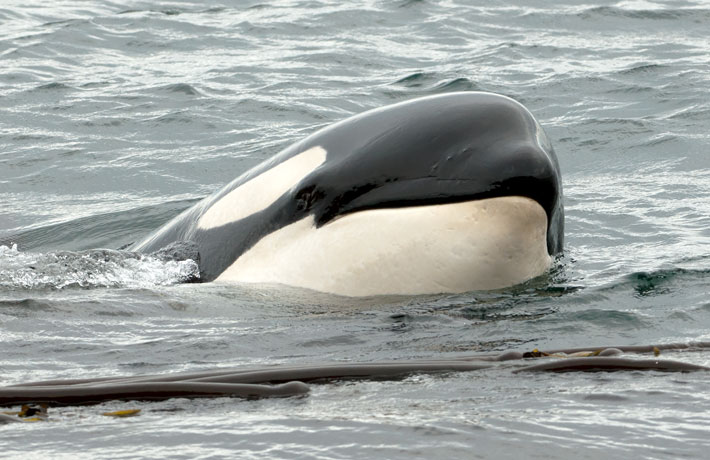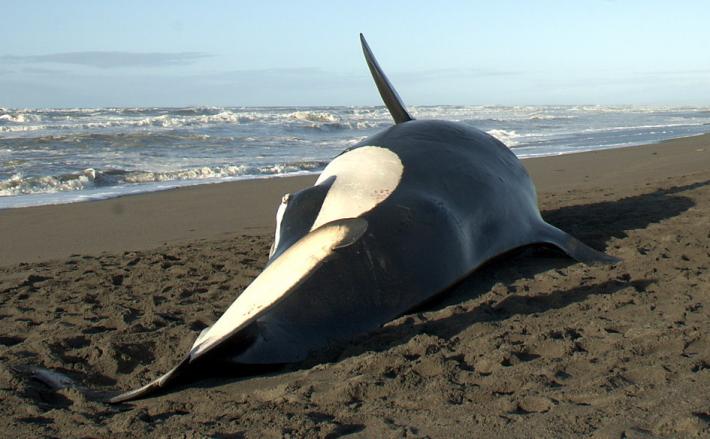 Killer whale strandings are always bad news. However, a new paper by SeaDoc scientists and collaborators shows that each orca’s death also is an opportunity to improve our understanding of the species and aid in the recovery of endangered populations.
Killer whale strandings are always bad news. However, a new paper by SeaDoc scientists and collaborators shows that each orca’s death also is an opportunity to improve our understanding of the species and aid in the recovery of endangered populations.
This first-of-its-kind study analyzed live and dead killer whale strandings in the North Pacific Ocean dating back to 1925. It showed that very few orcas that die wash ashore – just 10 per year over the entire North Pacific Ocean. While each rare stranding is a chance to gather a huge amount of data, until recently less than 1 out of every 50 dead killer whales was thoroughly examined.
That changed in 2004 when SeaDoc’s Joe Gaydos and Stephen Raverty, a veterinary pathologist from British Columbia, created a killer whale necropsy protocol that helped stranding responders maximize the amount of information learned from each orca carcass. Thanks to this and dedicated funding from NOAA to analyze samples, since 2004 scientists have performed necropsies on 1 out of every 3 killer whales that strand in the North Pacific – a remarkable 1600% increase in effort. The data collected – on causes of death, contaminants, and genetics -are already being used to help recover endangered killer whale populations.
The scientific citation:
Barbieri, Michelle M., S. Raverty, M.B. Hanson, S. Venn-Watson, J.K.B. Ford, J.K. Gaydos. 2013. Spatial and temporal analysis of killer whale (Orcinus orca) strandings in the North Pacific Ocean and the benefits of a coordinated stranding response protocol. Marine Mammal Science, DOI 10.1111/mms.12044

For those who want to get more detail on the study without reading the full manuscript, here's a slightly longer summary:
Efforts to learn more from stranded killer whales are working
In a first-of-its-kind study published last week in the journal Marine Mammal Science, researchers analyzed North Pacific killer whale strandings dating back to 1925.
“This was a herculean effort to learn more about one of the ocean’s top predators,” says lead author Michelle Barbieri, a former SeaDoc scientist and currently the lead veterinarian for the Hawaiian Monk Seal Research Program. “We could not have done this without the collaboration of dozens of killer whale scientists from around the world who provided stranding and population data from Washington State, Oregon, California, Alaska, Hawaii, British Columbia, Mexico, Japan and Russia.
The final report noted that while orcas are some of the most widely distributed whales on earth, very few dead ones are ever found. Over the last two decades, an average of just 10 a year have been discovered stranded across the entire North Pacific Ocean. The study determined that 88% of all reported killer whale strandings are fatal while only 12% make it off the beach alive. It’s those dead whales, though, that can provide critical clues to the species’ overall life history, genetics, health and causes of mortality. With such limited opportunity to do comprehensive sampling and studies, the study’s authors noted the disturbing fact that, until recently, less than 2% of those dead killer whales were thoroughly examined.
“Each stranded orca should be viewed as a unique opportunity to enhance our understanding of this magnificent species,” says co-author and veterinary pathologist Stephen Raverty. To maximize the science gathered from each stranding, Raverty and Joe Gaydos, SeaDoc Director and another of the paper’s co-authors, created a standardized killer whale necropsy protocol in 2004. The analysis of strandings since then has shown that the protocol -- along with funding from the US National Marine Fisheries Service and Canadian Department of Fisheries and Oceans dedicated to southern resident killer whale recovery – has boosted the collection of complete data from killer whale strandings. Where traditionally only one in fifty would be analyzed, one in three now get a full work-up.
While this new study was designed to look at stranding trends and did not evaluate the causes, necropsies on beached orcas have shown that they absorb extremely high loads of manmade toxins, suffer from infectious diseases, and in the case of fish-eating populations, depend primarily on severely depleted salmon stocks. With the standardized protocol now in place providing much more complete data on strandings, researchers are getting a clearer picture of killer whale life and death.
“As apex predators and flagship conservation species, killer whale strandings are sad events,” says Gaydos, “but this paper confirms that if we make every effort to understand why the stranding occurred, we will ultimately improve the fate of the species.”
Credits: Top photo by Jeff Hogan. Beached whale is of a 2005 stranding taken by Jeff Jacobsen, Humboldt State University Vertebrate Museum

